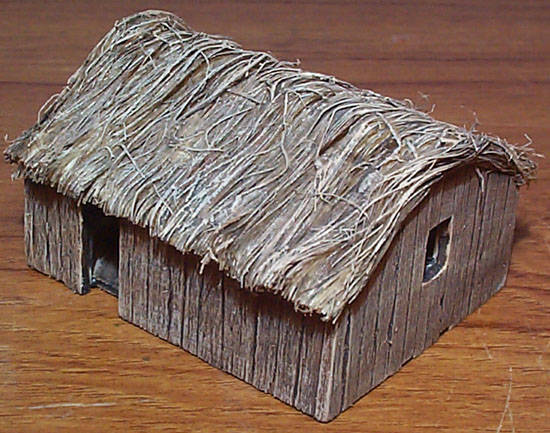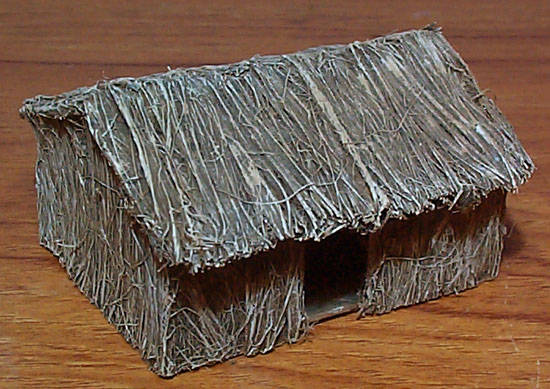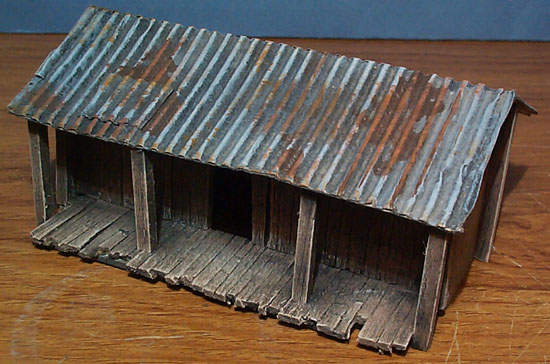Basic Structure

All the huts were made with an underlying structure of mounting board
stuck together with PVA. This gave a strong basic shape that was then
clad with a variety of materials. The walls are glued to the outside
of the rectangle which forms the base. I don't like to make buildings
with a little bit of ground around the edge because:
1) In my opinion it looks more natural without it.
2) It's more work.
3) It looks very strange if you put the building on a non-matching baseboard.
It is worth having a floor though, because it makes it a lot stronger.
- Cut the doors and windows out before you stick it together.
- Paint the hut black or dark brown inside before you stick the roof
on.
- Don't stick the roof on yet if you are going to thatch it with sisal
string. See below for the reason.
- The base board on the hut with a verandah sticks out underneath the verandah to strengthen it.
Hut 1 - Sisal Thatch & Balsa Walls


Balsa Wood walls
For the walls glue on 2mm balsa wood sheet with PVA, aligning the grain
of the wood vertically. When the glue has set, cut out the door and
window openings. Remember roughly where they are so you can poke a scalpel
into the middle and then cut outwards till you hit the mounting board.
(This is easy in practice).
Next use the wrong end of a scalpel blade to score the planks into
the balsa. If you want some joints in the other direction you will need
to score across the grain with the sharp end of the blade or it will
splinter.
Sisal Thatch
Sisal is a type of rough string. To get the thatch on put the two rectangles
of mounting board, which will form the two planes of the roof, together
face to face. Now wrap the string around them, untwisting it as you
go, and applying PVA fairly thickly to the card to stick it down. Once
the PVA has dried you can cut along one of the edges with a scalpel
and open up the two halves of the roof. There will tend to be a gap
in the middle where there is just string, which will increase the overhang,
so allow for this when you size the mounting board.
Hut 2 - Plumbers Hemp Roof & Walls


Plumber's Hemp Thatch
Stick chunks of plumber's hemp down with plenty of PVA. This is a messy
job, and best done on a small area at a time, or you will dislodge one
bit while doing the next. It will look appalling at first, but you can
neaten it up with scissors once the glue has dried.
It is best to paint the hemp with watered down PVA at the end, to make
sure it is really secure.
Painting Thatch
If you follow the normal drybrushing procedure of going from a very
dark colour to a very light colour, the thatch will look very dark.
Instead paint it with a mid brown.
Remember that colour saturation is decreased by drybrushing, so this can
be a fairly strong colour. Now wash with a dark brown before drybrushing
a couple of lighter coats. The end result will be a bit fresher and lighter
than if you had started with a dark brown.
Hut 3 - Corrugated roof & balsa walls


Corrugated Iron Roof
This is made from corrugated cardboard, not the stuff that big boxes
are made from, but cardboard with finer corrugations. This is usually
used for the boxes for small electrical and kitchen items.
First peel off one face of the cardboard. The best way I have found
to do this is to poke a pointed metal
thing I have into each corrugation to split off the top. A few tufts
of cardboard will remain which can be rubbed off the ridges with fine
sandpaper.
Once the cardboard has lost a face it will be very weak, so stick it
to mounting board backing. Patches can be added to it by peeling both
faces off a piece of cardboard and then gluing it on top of the main
piece. You can also intermingle panels of corrugated cardboard with
panels of balsa for ramshackle walls.
The posts for the verandah are solid bits of 4 or 5mm balsa. Underneath
the balsa verandah is mounting board to strengthen it.
Painting
Light grey was drybrushed over a coat of mid/dark grey to give a basic
colour. Then the rust was painted on the roof by putting on large patches
of dark brown and then drybrushing these with lighter leather and red-brown
tones.






